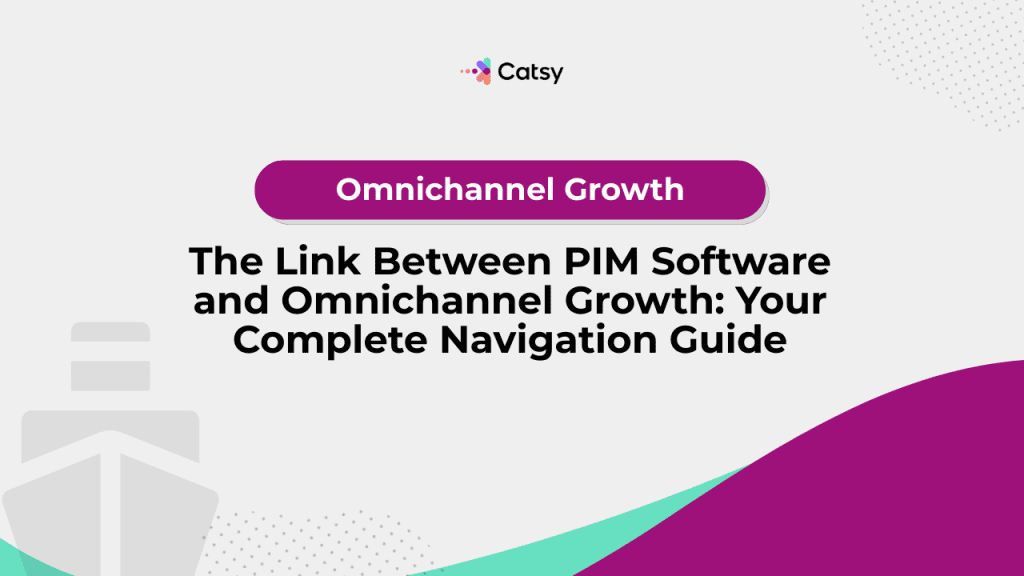The Link Between PIM Software and Omnichannel Growth: Your Complete Navigation Guide

Table of Contents
- Disconnected Product Data Is Costing You 287% Higher Revenue Potential
- Manual Catalog Management Destroys Customer Trust
- Poor Product Information Synchronization Limits Channel Expansion
- Customer Experience Fragmentation Pushes Shoppers to Competitors
- Without Scalable PIM Infrastructure, Growth Hits an Operational Ceiling
What You Will Learn
- How PIM software removes data silos to power omnichannel growth.
- Ways centralized catalog management boosts consistency and trust.
- How automation accelerates new channel launches.
- The role of unified data in creating seamless customer experiences.
- Why scalable PIM infrastructure is critical for sustained growth
In this Article
Are you watching your competitors thrive while you struggle to tread water? You may be trying to keep your product information consistent across your own website, Amazon, social media stores, and others. You may find yourself battling pricing mismatches, outdated images, and availability errors.
If you’re caught between dreams of rapid expansion and the reality of what that means, you may question whether omnichannel efforts are even worth it. Without the proper systems in place, a quick scale turns into fast chaos.
The truth of the matter is that businesses that are achieving omnichannel growth aren’t just lucky. They’re likely leveraging sophisticated technology that has transformed their complexity into an advantage.
Why platform selection determines your global retail success
The gap between businesses that thrive across multiple channels and those that struggle with it comes down to their approaches to product information management.
1. Disconnected product data is sabotaging your omnichannel strategy and costing you 287 percent higher revenue potential
While you manually coordinate product information across spreadsheets and platforms, integrated businesses run omnichannel campaigns with, unlocking revenue that disconnected approaches can’t reach.
While you’re bussing manually coordinating product info across your spreadsheets, your competitors are running campaigns that enjoy 287 percent higher purchase rates than single-channel efforts
Forrester research shows that 76 percent of global retail sales will still happen offline even as digital grows, making seamless omnichannel strategies essential.
Disconnected data causes inconsistencies in pricing, confusing product info, abandoned purchases, and escalating overhead as channels multiply.
How centralized product information unlocks omnichannel revenue potential
Modern catalog management systems eliminate data disconnection, but they still enable the consistency that drives exceptional performance.
- Single source of truth architecture: All of your product information originates from one authoritative database, ensuring consistency across unlimited channels and touchpoints
- Real-time synchronization capabilities: Updates made just once will automatically propagate to each of your connected channels within minutes, eliminating inconsistencies
- Channel-agnostic data structure: Information is organized to serve diverse channel requirements while still maintaining your brand’s voice across all customer touchpoints
- Automated quality assurance: Built-in validation rules prevent incomplete or incorrect information from reaching your customers on any platform
- Scalable distribution systems: Adding new channels becomes a configuration task rather than a major coordination project
Centralized management of your data turns your scattered, error-prone processes into systematic competitive advantages.
2. Manual catalog management is creating channel inconsistencies that destroy customer trust
Each time your customers see conflicting details, pricing, or availability, you erode their trust and lose sales. With 73 percent of shoppers using multiple channels and averaging nearly six touchpoints before purchase, inconsistent information, simply put, makes your business look bad. (Source)
When you scale, your manual coordination processes begin to fail. Each channel has unique formatting requirements, tech constraints, and update schedules. This makes inconsistencies inevitable when you’ve got five teams working on fifteen processes.
How automated catalog management ensures brand consistency
Managing your product information systematically eliminates the challenges that come with human error and coordination.
- Automated format optimization: Content automatically adapts to each channel’s requirements while maintaining consistent brand voice
- Workflow-based approval systems: Changes go through structured review processes before reaching customers, ensuring accuracy and brand compliance
- Template-driven consistency: Standardized formats ensure that similar products present consistently across all channels while respecting the requirements of the platform
- Error prevention systems: Validation rules catch potential inconsistencies before they reach customers, protecting your brand reputation and customer experience
- Audit trail maintenance: Complete change tracking enables quick identification and resolution of any issues that do arise
An automated system will take your channel management from nightmare to a strategic advantage that builds consumer confidence and drives conversion.
3. Poor product information synchronization is limiting your expansion into profitable new channels
Is your team spending weeks setting up each new sales channel manually? Your competition isn’t. Businesses with systematic approaches can launch in just days, capturing advantages and opportunities that your manual processes miss.
E-commerce channels are ubiquitous, and this creates both unprecedented opportunities and operational challenges. Emerging platforms like social and voice shopping require different data, compliance, and formatting.
Without automated synchronization, each new channel becomes a major project that requires significant overhead. This limits your ability to test and expand into profitable new opportunities.
How systematic synchronization enables rapid channel expansion
Advanced PIM software and omnichannel growth capabilities reconstruct your expansion efforts from complex processes to strategic opportunities.
- Pre-configured channel templates: Popular platforms have ready-made integration templates that enable you to launch in days, not weeks!
- Automated compliance checking: Systems ensure that your product information meets each channel’s specific requirements and formatting standards
- Bulk distribution capabilities: Entire catalogs can be syndicated to new channels simultaneously… no more one-by-one product setup!
- Performance optimization tools: Channel-specific SEO and conversion optimization is automatic based on platform best practices
- Scalable architecture: Systems handle unlimited channels without performance degradation or proportional increases in maintenance overhead
Systematic syncing allows for aggressive testing and strategies for expansion. You’ll capture market opportunities while your competitors struggle with their manual processes.
4. Customer experience fragmentation is driving shoppers to competitors with seamless experiences
Modern consumers shop with convenience, value, and experience in mind. They don’t just shop the channels.
When your product information differs across touchpoints, it creates friction. This friction will, obviously, push your consumer right into the arms of your competitor. However, companies with strong omnichannel strategies see 9.5 percent annual revenue growth versus 3.4 percent for weaker ones. This is largely due to customer experience.
Fragmentation happens when mobile and desktop experiences differ, your social posts don’t match your website info, in-store staff lack the details customers see online, or checkout processes vary across channels.
How unified customer experiences drive loyalty and growth
Integrated catalog management creates consistent, high-quality experiences that build customer confidence and drive superior business performance.
- Cross-channel consistency: Customers receive the same high-quality information regardless of how and where they interact with your brand
- Personalization at scale: Unified data allows you to grant your customers individualized experiences that acknowledge their preferences across all touchpoints
- Seamless journey continuity: Customers can start shopping on one channel, then complete purchases on another without encountering conflicts of information
- Enhanced customer service: Support teams have access to complete, current product information that enables faster, more accurate assistance
- Loyalty program integration: Unified data supports recognition and rewards programs during each customer interaction
Unified experiences will convert even the most casual browser into a loyal customer. That customer becomes a brand advocate, driving word-of-mouth marketing and accelerating sustainable growth.
5. Without scalable PIM infrastructure, your omnichannel growth hits an operational ceiling
The most successful omnichannel retailers have an infrastructure that was designed for expansion … without adding resource strain. Manual efforts and siloed channel management may be fine for just three channels. But under the weight of ten, your systems collapse.
Research shows true omnichannel strategies drive results. 46 percent of businesses report higher customer lifetime value from deeper engagement and stronger relationships enabled by integrated approaches.
How scalable infrastructure enables unlimited growth potential
Modern product information management platforms provide the foundation for expansion your business needs to grow efficiently.
- Unlimited channel capacity: Systems can handle exponential growth in channels, products, and complexity without requiring architectural changes
- Automated workflow scaling: Processes that work for hundreds of products automatically scale to handle hundreds of thousands… without manual intervention
- Performance optimization: Advanced caching and distribution will provide fast response times regardless of catalog size or channel complexity
- Integration flexibility: API-first architectures support connections with current or future platforms … without the need for custom development
- Cost efficiency: Operational expenses remain proportional to business value; they don’t multiply as your channels grow
Scalable infrastructure makes complicated expansion easy, turning your challenges into advantages.
Make Catsy DAM and PIM Software an Extension of Your Team
Book a Free DemoTransform channel chaos into systematic competitive advantage
The gap that exists between omnichannel leaders and those who fall behind isn’t market conditions. It’s systematic product information management that makes multi-channel listing profitable.
Each day spent battling manual inconsistencies is a day that your competitors edge ahead. The answer lies in PIM software.
Catsy’s comprehensive omnichannel platform delivers the systematic capabilities that successful businesses leverage:
- Centralized catalog management eliminates data silos while allowing for unlimited channel expansion without adding complexity
- Automated synchronization maintains consistency across customer touchpoints while allowing you to expand rapidly into new markets
- Channel optimization tools maximize performance on each platform while maintaining your brand consistency and your teams’ efficiency
- Scalable architecture grows with your business without requiring system replacements or major reconfigurations
- Customer experience optimization builds loyalty and drives growth through seamless, high-quality interactions across each touchpoint
Your omnichannel success is too important to leave to spreadsheets! Choose a platform that makes exceptional experiences systematic and scalable… a system like Catsy.
Key Takeaways
- Disconnected data reduces revenue potential and damages trust.
- Automation ensures brand consistency across all channels.
- Systematic synchronization speeds up channel expansion.
- Unified data creates seamless, loyalty-building experiences.
- Scalable PIM infrastructure removes growth ceilings.
Want more tips, tutorials, and insights on product content and e-commerce operations?
Stay connected. We post regularly to help brands like yours scale smarter.
Are You Ready To streamline your product content management?

Frequently Asked Questions
Product Information Management software centralizes your product data, automates updates, and ensures consistency across each of your channels. This enhances both trust and customer experience.
Manual updates create inconsistencies, slow your product launches, and limit your ability to scale efficiently.
Yep! With pre-configured templates, bulk distribution, and automated compliance checks, our PIM enables you to launch to new channels in just days.
A PIM like Catsy ensures that your product details, pricing, and availability are consistent across touchpoints, This creates a smooth, reliable shopping journey for each of your customers.
Scalable PIM handles unlimited products, channels, and growth without a decline in performance or a need for major infrastructure changes.
Subscribe For More Content
Sign up for monthly tips on how to drive revenue with product content.




